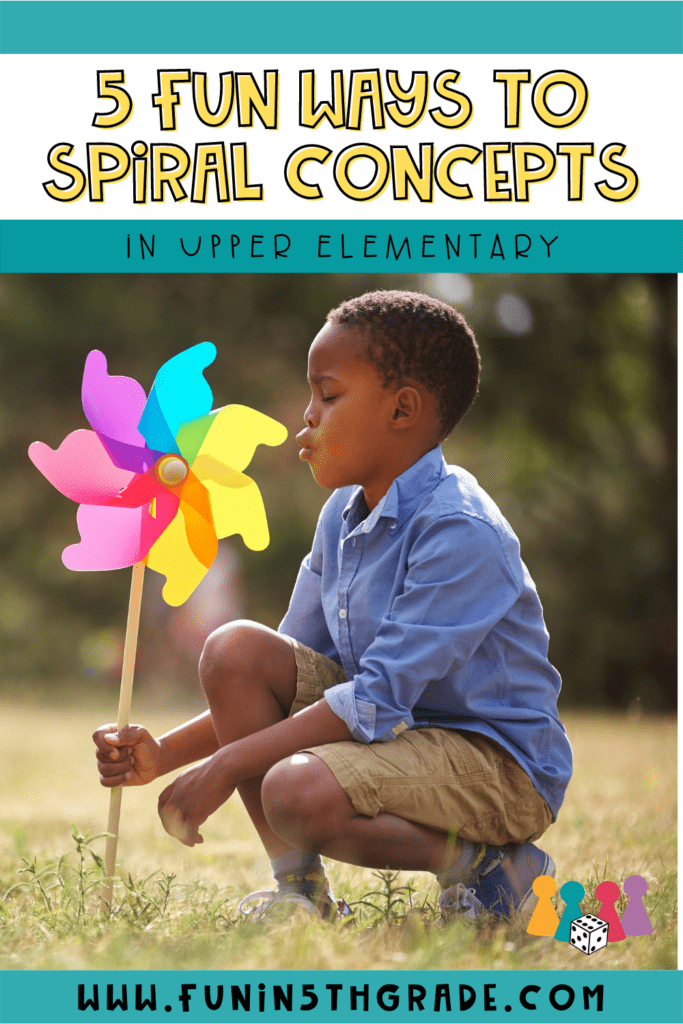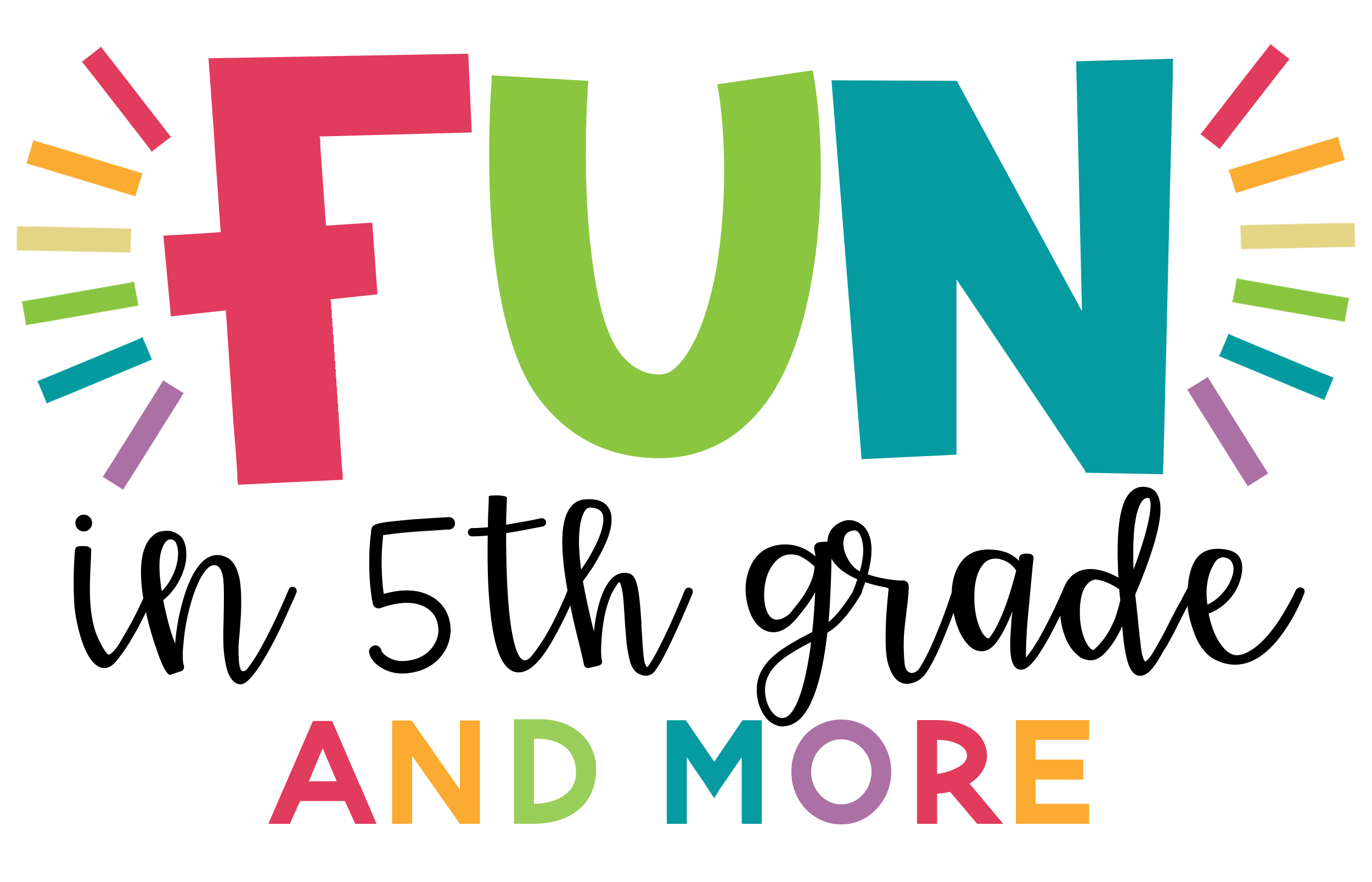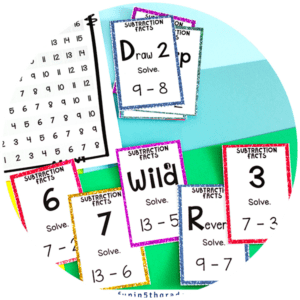Spiral concepts in upper elementary without becoming redundant or dull with these 5 fun activities!
We often talk about spiraling concepts in upper elementary, and it is our belief that spiraling concepts help to promote the long-term retention of skills and a deeper understanding of ideas and content.
When we spiral concepts into our lessons and activities, students learn a little more each time, and that creates the ongoing growth that we love to witness in our students.

What is concept spiraling?
When you spiral concepts in upper elementary, you are taking concepts or skills that were previously taught and sprinkling them in sporadically throughout the year to keep them fresh in your students’ minds.
Common ways teachers spiral concepts and skills are through purposefully chosen centers and adding questions related to the concepts in other work and handouts.
It is the repetition of concepts and the growing understanding of how those concepts and skills show up in different contexts.
Think about a spiral staircase. Although the staircase is spiraling back on itself, the person taking the stairs still moves upward.
This is important!
We don’t want the students to remain stagnant. We want them to constantly grow and improve their understanding of the concepts we’re working on, so we need to get creative and not always spiral the concepts in the same way or with the same amount of rigor.
In an effort to change things up and try spiraling standards and concepts in new ways, we are going to introduce 5 of our favorite ways to spiral concepts!
5 FUN Ways to Spiral Concepts in Upper Elementary
Spiraling concepts doesn’t just have to be question and answer sessions during direct instruction…although it could be, that wouldn’t be much fun, would it. It also doesn’t have to be pop quizzes and test questions. Spiraling standards can be a lot of fun. Think about it. If you like playing board games, do you just play a game once and then put it away and never touch it again? You could, but most people play games over and over with the goal of changing and improving their strategy each time. This is a great analogy for the way we like to spiral standards in the classroom.
Long story short, much of our spiraling strategy has to do with games!
#1 | Using games to spiral standards
I used to use review packets and worksheets to review concepts and skills, but then I realized that although I knew the review was good for them, my students were super bored and unengaged! This could not do!
So, I got creative.
I started using games to spiral the standards by mixing in questions related to previously-learned concepts and creating interactive activities that gave my students a chance not only to practice previously learned skills and concepts but also the incentive to improve.
I wrote a whole post about this, so make sure to check out Why You Should Use Games to Spiral the Standards.
#2 | Use warmup to spiral concepts that are used all year.
Think about the warm-ups you do in the classroom already. Is there a way to reintroduce and practice concepts as part of that warm-up?
For example, when you are introducing a new concept, add in some questions related to old concepts as well, and then pay attention to the student’s answers.
Include a variety of questions from different standards and always check in on which questions they are getting incorrect. Then build on that concept during small groups or weave it into centers using one of the other strategies on this list.
Our Daily Math Warm-Ups are a great example of how concepts can be spiraled into warm-ups in a fun, unassuming way.

#3 | Using close reads
Close reads are incredibly high-interest because they are created based on super interesting and engaging texts, and in our close reads, we use mystery pictures to up the level of engagement.
In addition to getting the students reading, working on dissecting texts, and practicing reading comprehension skills, close reads also spiral standards, skills, and concepts.
While your students do close reads throughout the year, they are constantly working through the skills of annotating and questioning, which are skills that take work but will grow and evolve with practice.
Students are also working through several different literary comprehension skills each time. If you use several close reads from the bundles over the course of the year, then students are going to get a variety of different types of questions that will help them grow and engage the text in a different way.
This is essentially the skyscraper-level spiraling of reading comprehension skills and concepts.

#4 | Fun Friday
On Friday…we play games, and you better believe that I use those games to spiral standards.
I always had lots of board games on hand that I could change out the cards for and use task cards instead. That way, the games could be used to work on concepts while also being fun.
We also used a variety of virtual games like these digital board games and these game shows.
When choosing the Fun Friday games for the week, I often pulled U-KNOW decks, task cards, or games that worked on skills that I saw students struggling with this week.
That is truly the beauty and goal behind many of our bundles. We’ve created many of our games with spiraling standards and skills in mind. In fact, depending on what skill you want students to work on or what concept you want to spiral back on that week, you could probably find a variety of different types of games to choose from just in our store alone.
#5 | Make it physical
When you think about how you spiral concepts in your classroom, how many of your strategies include the students moving? Probably not many.
I want to challenge you to get your students moving. Kids learn in lots of different ways, and sometimes putting a physical movement to an activity can help it stick.
I know this is great in theory, but what does it actually look like?
Let’s consider the U-KNOW game to the right. There are several questions in each deck that are yes/no questions. So for one day, consider having students do one action for yes and a different action for no.
For example, if you state the question, “Is the number 24 prime or composite?” Then the students will stand on their right leg if the answer is yes or stand on their left leg if the answer is no.

Another way to make the activities physical would be to put students in groups. Then you give each group a question, and then they have to find a way to ‘show’ you with their bodies and any available props why they know their answer is right. They may do this by grouping students, holding up their hands, rearranging markers on the nearby table, etc.
Spiraling concepts in upper elementary can be a lot of fun… when we let it be. Consider all the different ways you can appeal to your learners’ interests and learning styles using some of the ideas above. Consider trying several different ways to see what appeals to your students best. No matter what, if they are engaged, growing, and having fun, you’re on the right track!





